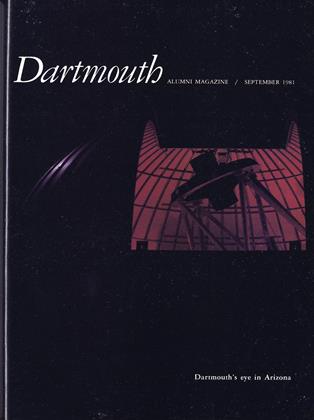VERMONT: A HISTORY by Charles T. Morrissey '56 Norton, 1981. 235 pp. $12.95
Charlie Morrissey has written a delightful new book summing up in personal terms the essence of Vermont. Although the book is entitled "Vermont: A History," it is not a history in the conventional sense but is rather designed to describe and explain the character of the state and its people.
Morrissey is admirably equipped to give us this sort of sensitive and personal interpretation. Although born in Massachusetts and educated across the river in New Hampshire, he has absorbed the essence of his adopted state of Vermont sufficiently to be a treasure-trove of information and anecdotes that humanize its history. He brings to his task a somewhat idealized love of the state, its people, and its traditions.
The book is loosely organized into four parts. In the first, Morrissey defines the characteristics of the state and its people as he sees them. He has a sensitive eye for the beauty of the countryside and the appealing and romantic aspects of Vermont's small towns and hidden valleys. His portrait of this aspect is loving but sometimes fulsome. He also makes no secret of his distaste for the changes that are being wrought in the essentially rural character of the state by growth and the gradual encroachment of modern industrial society.
The second part of the book is what the title promises a history. But rather than simply chronicle the significant events which have occurred since Samuel de Champlain first explored the area in 1609, Morrissey instead uses anecdotes and sidelights to history to interpret the main currents of Vermont history and to help explain why Vermont is different from any other state.
The history is concentrated on Vermont's early, formative years: the preRevolutionary conflict between New Hampshire and New York over who owned the area which would become Vermont; Vermont's part in the Revolutionary War; the post-Revolutionary period of the Republic of Vermont; and finally the admission to statehood. As Morrissey explains the central role of Ethan and Ira Allen and their Green Mountain Boys during these turbulent years, these legendary figures become more real but also somewhat larger-than-life.
Though Morrissey pays less attention to the history of the nearly 200 years that have elapsed since Vermont became a state, he sketches the economic and political crosscurrents of a backwater state with declining fortunes that made its mark on the nation more by its sons who emigrated than by its own achievements.
In the third part of the book, he undertakes to convey a sense of the Vermont heritage. He explores such traditional qualities of Vermonters as frugality and self-restraint, industriousness and ingenuity, independence and lack of pretension, and he illuminates them by stories of real Vermonters of all eras and of all stations. At the same time he weaves into the fabric of this section a sense of how the location, the topography, the climate, and the history of the state have left their imprint on its people. This section is simultaneously Morrisse.y's paean to the glories of the Vermont tradition and his lament at the inadequate efforts to preserve and protect it.
Finally, he speculates briefly, with a mixture of hope and pessimism, on the future of the state and the ability of Vermonters to preserve the beauty and the unique character of their state.
This is a captivating book that will interest a wide range of readers. While it introduces the "flatlander" to Vermont fondly and gracefully, at the same time it offers new insights to even the most dedicated Vermontophile.
Among other distinctions, Vermont is oneof six states that sends more senators thancongressmen to Washington. Mallary wasthe state's lone congressman from 1972 to1974.
 View Full Issue
View Full Issue
More From This Issue
-
 Feature
FeatureThe big eye in Arizona
September 1981 By Shelby Grantham -
 Cover Story
Cover StoryInauguration of the 14th President: The Spirit of Eleazar Wheelock ... Transmitted through his Successors'
September 1981 -
 Feature
FeatureAll the Presidents's People
September 1981 By J. N. -
 Class Notes
Class Notes1956
September 1981 By Clement B. Malin -
 Article
ArticleHistory Without Battles
September 1981 By Beth Ann Baron '80 -
 Class Notes
Class Notes1950
September 1981 By Jacques Harlow
Richard W. Mallary '49
Books
-
 Books
BooksIN A SPERM WHALE'S JAWS
October 1954 By ALEXANDER LAING '25 -
 Books
BooksTHE LAUGH MAKERS: A PICTORIAL HISTORY OF AMERICAN COMEDIANS.
March 1958 By ALLEN R. FOLEY '20 -
 Books
BooksA BIBLIOGRAPHY OF THE WORKS OF EUGENE O'NEILL.
NOVEMBER 1931 By Benfield Pressey -
 Books
BooksA SHORT HISTORY OF AMERICAN LITERATURE, VOL. 1: FOUNDATIONS OF AMERICAN LITERATURE,
January 1952 By H. G. R. -
 Books
BooksKEATON.
DECEMBER 1967 By J. BLAIR WATSON -
 Books
BooksALL THE BEST IN HAWAII
January 1950 By Mildred L. Saunders



